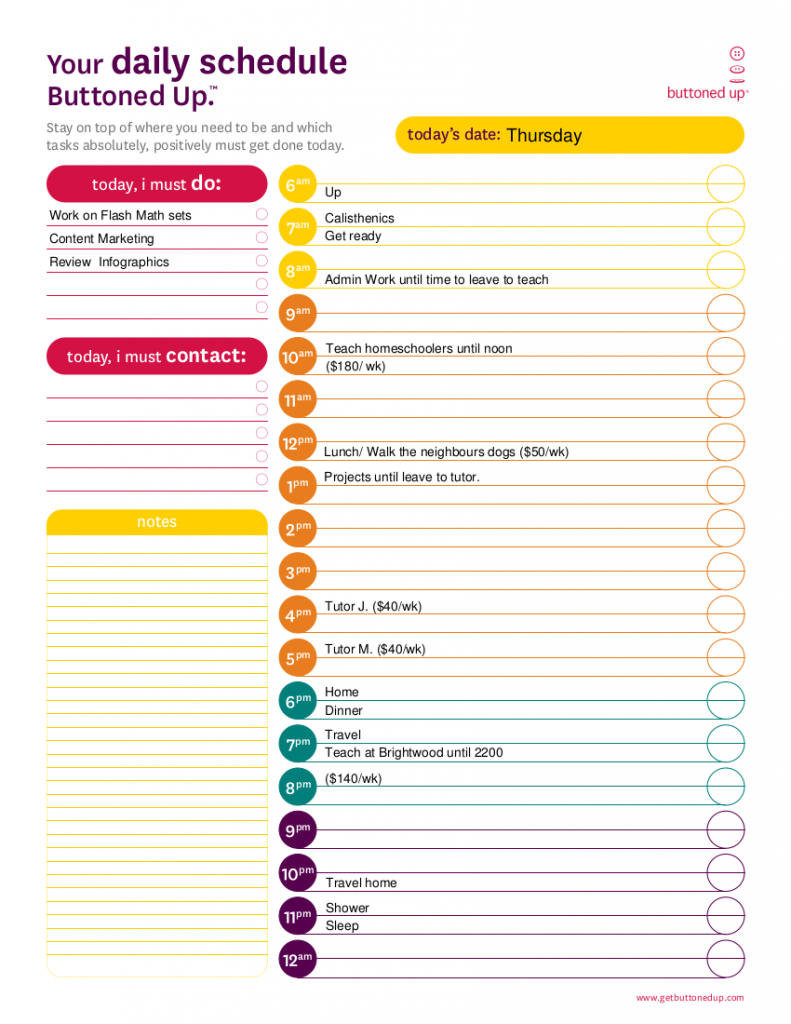When Insanitek came to life, it wasn’t plan A. Plan A was to get an industry job, stay around for a decade or two building up money and contacts. Then I was going to start Insanitek as an R&D firm with an apprenticeship side. What I’m doing right now wasn’t even on the radar.
What I’m doing now is something called bootstrapping. It’s common in the tech world where you have a virtual product and low overhead — you can start in the library, a friend’s spare room, or your parent’s basement. They key to bootstrapping is to keep expenses at a minimum while growing the income base.
I* do that by working nearly 14h a day. A day looks like this:
Keep in mind that I don’t teach at Brightwood every quarter, nor do I tutor all year round. In fact, I teach at Brightwood usually one quarter a year, and the kids get summer months off. The only solid income I have to build Insanitek on is that from the homeschoolers. (I use the cash I make walking my neighbour’s dogs to pay for the dentist and other things like that.)
Bootstrapping is not a glorious lifestyle, especially if the product or service isn’t digital.
 A lot of people wear the “bootstrapping” title like a badge of honour. It is something akin to saying you’re tough, you can deal with a lot, you have a lot of hustle, and, on top of it, you’re smart with money. You can’t do it alone. You have to rely on others for paying for your daily living expenses — especially if you starting from nothing. If you have savings from previous employment, you may find that you can travel the world while producing and selling digital products as you go.
A lot of people wear the “bootstrapping” title like a badge of honour. It is something akin to saying you’re tough, you can deal with a lot, you have a lot of hustle, and, on top of it, you’re smart with money. You can’t do it alone. You have to rely on others for paying for your daily living expenses — especially if you starting from nothing. If you have savings from previous employment, you may find that you can travel the world while producing and selling digital products as you go.
Sounds like a fun badge to earn, eh?
But what if you want to serve the world with a product that isn’t digital or a service that takes more than a group Skype call?
You gotta be smart with money.
That’s what I do at Insanitek. No penny get spent without consideration to where it’s going. Every time I spend money, it’s with an eye to growth. Things that a business can’t do without are:
- Email Service Provider — so you can keep in contact with your perspective clients and serve them.
- Time savers — such as Buffer to share the word via social media and Acuity to save time on scheduling appointments.
- People that make it all possible and grow.
- If you’re going to be online, a good webhosting service and your own domain.
$50 a week goes to Krystle, Insanitek’s main writer. I recently brought on another writer, Karen, who gets another $50 a month. That’s $250 a month. Then, there is the software. I look for ways to save, so I pay yearly for things that we use as often as possible. We use Buffer ($50/month, Acuity ($209/yr), Aweber ($193.80/yr), and InMotion ($131.88 yr).
I’m saving up money for putting Buffer on the $1010/yr plan or replacing them all together to automate our social media feeds. I’d rather have something that also let us look at and respond replies as well. Engagement is something I really want all of us affiliated with Insanitek to do better.
One of the things that is slightly up in the air that is a may not need, but definitely feels like you need it from time to time, is a coach. I like Chris Brogan for his down to earth approach and affordable webinars ($200/yr) that helps keep me on track when I feel like I’m floundering around. Some would say this is a need — they are marketing their coaching services. Others would say it isn’t because you can find free help. Frankly, I’m of the opinion you should have a few people who can direct you that have been there, done that, but if you don’t put the work in for yourself, then it’s useless.
But what about the science?
 Science is expensive. We have some money left over at the end of the month, and every bit goes into savings. Graphic designers help us make better educational materials for the homeschoolers and educators. They also make infographics come alive — and we use these to facilitate conversations about science.
Science is expensive. We have some money left over at the end of the month, and every bit goes into savings. Graphic designers help us make better educational materials for the homeschoolers and educators. They also make infographics come alive — and we use these to facilitate conversations about science.
Then, we have to have a cunning plan.
Just like any science project, actually. You have to ask questions, plan how you’re going to answer it, and then carry it through. Here we have to stick to time lines, deliver results, and find ways to make money with the same materials (or project) that we are using in any given experiment.
That’s the part that most people’s brains stall out at. How do you make money off of science? Science is just research, right?
Well, not if you want to keep it alive and well on its own merit.
The thing that I’ve learnt to come to terms with is that I don’t want to rely on a handout. We aren’t a big company, so we are often overlooked. We aren’t impressive enough to win grants. That means we have to earn the money on our own. And that means getting creative and down to business.
I’ll use my research as an example. My big question is cleaning up military sites with bioremediation. I want to know what kinds of plants can suck up the toxins efficiently while leaving the nutrients that would be needed to support life later. The base of this is soil science, which I sell services to local homeowners and businesses that want to make their area “greener” — in that they want the plants they plant to survive.
Homeowners and businesses pay me to analyse their soil. With the profits, I can can also have small-scale research on the other side of my dinky lab area devoted to poisoning — then rehabilitating soils with a variety of plants.
It’s far from perfect, but it’s working on a shoestring budget that makes the science work for us while we work for it.








